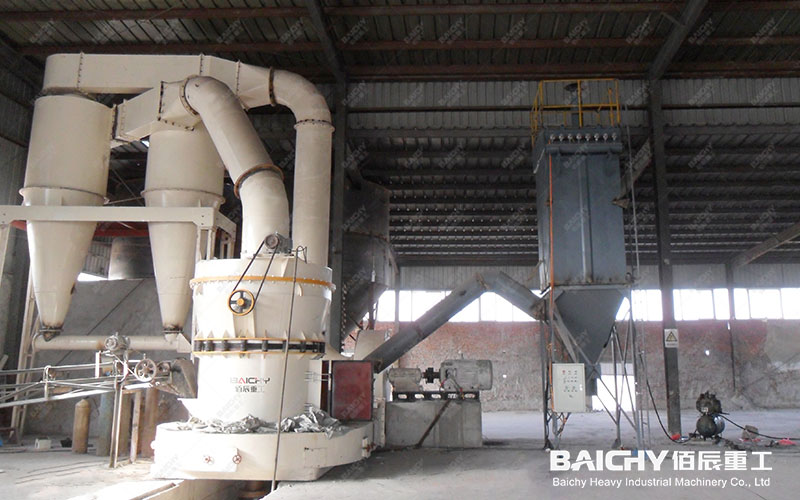
Raymond mill is a common type of calcium carbonate grinding equipment. It has the characteristics of compact structure, small footprint, high grinding efficiency, and adjustable fineness. It is used for materials of various hardness, such as limestone, calcium carbonate, etc.
The calcium carbonate grinding production line is mainly responsible for grinding non-flammable and explosive minerals with a Mohs hardness of less than 8 and a humidity of less than 6% into powder, and packaging them through automated packaging equipment. Its production capacity is 10 tons/hour, which can meet the needs of large-scale production.
Main equipment and operating principles of calcium carbonate grinding production line
1. The vibrating feeder evenly transports materials to the jaw crusher.
2. The jaw crusher moves the movable jaw back and forth by changing the angle between the movable jaw and the liner to achieve the initial crushing of the material; the large pieces of material are crushed into smaller particles for subsequent grinding.
3. The bucket elevator lifts the crushed raw materials to the storage bin for subsequent processing.
4. The electromagnetic vibrating feeder evenly feeds the raw materials in the storage bin into the main grinding machine for grinding.
5. The main grinding machine drives the central axis to rotate through the reducer, and many grinding rollers are installed on the axis. The grinding roller can not only rotate around the central axis, but also around the grinding ring. The material is sent into the middle of the grinding roller and the grinding ring under the action of the shovel, and is crushed into powder under the action of the grinding pressure. The ground powder is blown up by the fan and passes through the analyzer. The material that meets the fineness requirements passes through the analyzer, and the powder that does not meet the requirements returns to the grinding chamber for further grinding. Grind the material to the required fineness.
6. Large cyclone collector and bag dust collector The ground powder is blown into the analyzer for sorting under the action of the blower. The powder that does not meet the fineness requirements returns to the grinding chamber for grinding, and the powder that meets the fineness enters the large cyclone collector with the air flow for separation and collection. The collected powder is discharged through the powder outlet pipe, which is the finished powder. At the same time, the bag dust collector is used to collect the fine powder brought in by the residual gas, purify the residual gas and then discharge it. Collect the finished powder and deal with the dust generated during the grinding process.
7. The ton bag packaging equipment for calcium carbonate powder consists of a feeding system, a weighing system, a control system, an automatic dust collection system, a pneumatic system, a conveying system, and a machine body. It is an automatic packaging equipment that integrates electronic weighing, automatic bagging, and dust removal, with a high degree of automation, high packaging accuracy, and adjustable packaging speed. The ground calcium carbonate powder is automatically packaged.

Advantages of calcium carbonate grinding production line
1. Efficient grinding: using advanced grinding main machine, high grinding efficiency and low energy consumption.
2. High degree of automation: from material transportation, crushing, grinding to packaging, the entire production process is automated and controlled to reduce manual intervention.
3. Environmental protection and energy saving: using equipment such as bag dust collector to effectively reduce dust emissions and meet environmental protection requirements. At the same time, the overall energy consumption of the production line is low, saving energy.
4. Stable quality of finished products: through precise sorting and collection systems, the fineness and quality of the finished powder are ensured to be stable.











